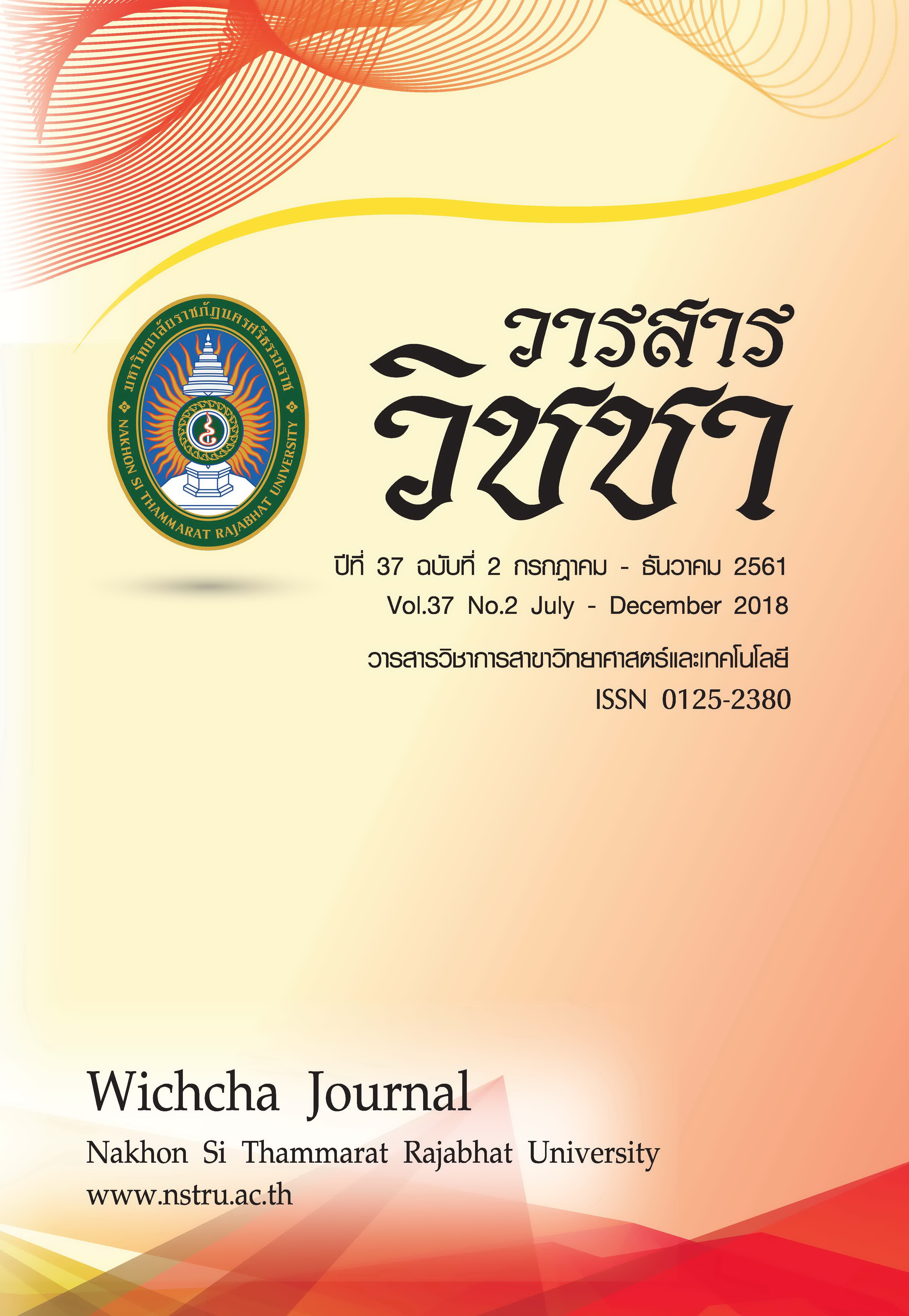Growth Performance and Growth Pattern of Clown Anemonefish (Amphiprion ocellaris Cuvier, 1830) Rearing With Green Feather Algae and Without Sea Anemone Conditions
Main Article Content
Abstract
The growth performance and growth pattern of clown anemonefish (Amphiprion ocellaris Cuviere, 1830) were studied. The fish cultured for sixty days in the glass aquarium. The experiment was divided into three treatments (sea anemone, lack of the material and green feather algae). The initial average weights and lengths of fish were 0.14±0.01 0.14±0.01 and 0.14±0.01 gram, and 1.88±0.02 1.87±0.02 and 1.87±0.02 centimeter, respectively. The results showed the average weight were 0.45±0.11 0.36±0.07 and 0.64±0.11gram, respectively. The average total lengths were 2.80±0.23 2.86±0.16 and 3.03±0.25 centimeters, respectively. The specific growth rates were 1.34±0.63 0.24±0.25 and 2.05±1.26 percent per day, respectively. The weight gains were 181.11±8.84 92.68±7.09 and 289.80±9.93 percent, respectively. The average daily growths were 0.0032±0.002, 0.0003±0.000 and 0.0060±0.004 grams per day, respectively. The survival rates were 82.50±2.61, 17.50±2.01 and 75.00±5.00 percent, respectively. The growth performance was significant difference (P<0.05). The growth pattern of clown anemonefish rearing with sea anemone, green feather alga were isometric. The length-weight relationships equations of mixed sexes were W = 0.021TL3.00 (R2 = 0.98), W = 0.021TL3.00 (R2= 0.97) respectively, and lack of the material was allometric (W = 0.029TL2.48, R2 = 0.97). The growth performance of clown anemonefish rearing with green feather alga, it has trends to be higher than every treatments.
Article Details
เนื้อหาและข้อมูลในบทความที่ลงตีพิมพ์ในวารสารวิชชา มหาวิทยาลัยราชภัฏนครศรีธรรมราช ถือเป็นข้อคิดเห็นและความรับผิดชอบของผู้เขียนบทความโดยตรง ซึ่งกองบรรณาธิการวารสารไม่จำเป็นต้องเห็นด้วยหรือร่วมรับผิดชอบใด ๆ
บทความ ข้อมูล เนื้อหา รูปภาพ ฯลฯ ที่ได้รับการตีพิมพ์ในวารสารวิชชา มหาวิทยาลัยราชภัฏนครศรีธรรมราช ถือเป็นลิขสิทธ์ของวารสารวิชชา มหาวิทยาลัยราชภัฏนครศรีธรรมราช หากบุคคลหรือหน่วยงานใดต้องการนำข้อมูลทั้งหมดหรือส่วนหนึ่งส่วนใดไปเผยแพร่ต่อหรือเพื่อการกระทำการใด ๆ จะต้องได้รับอนุญาตเป็นลายลักษณ์อักษรจากวารสารวิชชา มหาวิทยาลัยราชภัฏนครศรีธรรมราชก่อนเท่านั้น
The content and information in the article published in Wichcha journal Nakhon Si Thammarat Rajabhat University, It is the opinion and responsibility of the author of the article. The editorial journals do not need to agree. Or share any responsibility.
References
เดชา รอดระรัง และนงนุช สุวรรณเพ็ง. (2547). การอนุบาลกุ้งก้ามกรามด้วยความหนาแน่นสูงในบ่อซีเมนต์. กรุงเทพฯ: สํานักวิจัยและพัฒนาประมงน้ำจืด กรมประมง.
ธรณ์ ธำรงค์นาวาสวัสดิ์. (2544). ป๊ะป๋า ปลาการ์ตูน. แอดวานซ์ ไทยแลนด์ จีโอกราฟฟิค. 6(46), 248-290.
ธีญาภรณ์ แก้วทวี สุพัทชฎา นวลทองแก้ว อรวรรณ คงสุวรรณ ยุทธพงษ์ สังข์น้อย และอานนท์ อุปบัลลังก์. (2561). การลดปริมาณแอมโมเนียรวมด้วยสาหร่ายพวงองุ่น Caulerpa lentillifera และส่าหร่ายผมนาง Gracilaria fisheri ในการเลี้ยงปลาการ์ตูนส้มขาว Amphiprion ocellaris. วารสารมหาวิทยาลัยทักษิณ, 21(3), 91-98.
นันทวัฒน์ โชติสุวรรณ. (2555). ปลาทะเลสวยงาม ที่เพาะพันธุ์ได้ ในประเทศไทย. Aquarium Biz. 2, 125.
ฝ่ายเผยแพร่วิทยาศาสตร์. (2560). ดอกไม้ทะเลสิ่งมีชีวิตครึ่งพืชครึ่งสัตว์. สืบค้นเมื่อ 12 ธันวาคม 2561, จาก: https://www.nstda.or.th/sci2pub/sarawit/Sarawit-Issue049.pdf.
วิมล จันทรโรทัย ประเสริฐ สีตะสิทธิ์ ศิริมล ชุ่มสูงเนิน และสมฤกษ์ ชินมุข. (2535). อาหารที่ระดับโปรตีนต่างกันแต่พลังงานคงที่ต่อการเจริญเติบโตและไขมันสะสมในปลาสวาย. กรุงเทพฯ: สถาบันวิจัยประมงน้ำจืด กรมประมง.
Beck, M.W. (1995). Size-Specific Shelfic Limiitation in Stone Crabs A The Demographic Bottleneck. Journal of Ecology. 76(1), 968-980.
Cohen, D.Z., Raanan, U. and Arieli, U. (1983). The production of the freshwater prawn Macrobachium rosenbergii in lsrael : Improvedvconditions for intensive monoculture. Bamideh. 35(2), 31-37.
Dhaneesh, K.V., Devi, K.N., Kumar, T.T.A., Balasubramanian, T. and Tissera, K. (2012). Breeding, embryonic deveopment and salinity tolerance of Skunk clownfish Amphiprion akallpisos. Journal of King Saud University-Science. 24(3), 201-209.
Ricker, W.E. (1979). Growth rate and models’ in Fish Physiology. (8th ed). London: W.S. Academic Press.
Rounsefell, G.A. and Everhar, W.H. (1953). Fishery Science. New York: John Wiley and Sons Inc.


